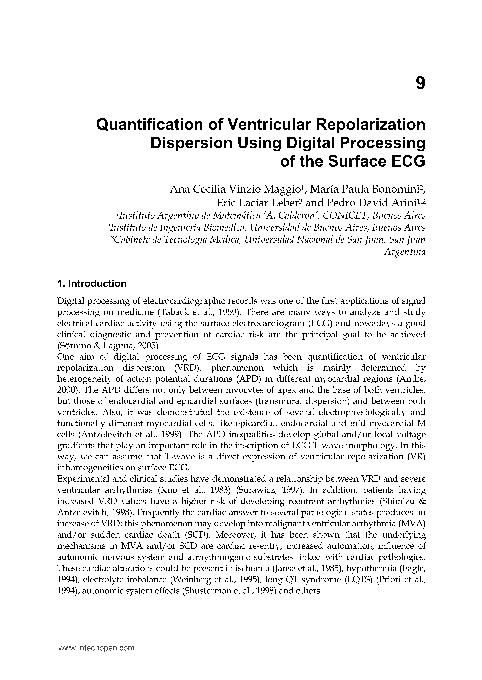Mostrar el registro sencillo del ítem
dc.contributor.author
Vinzio Maggio, Ana Cecilia

dc.contributor.author
Bonomini, Maria Paula

dc.contributor.author
Laciar Leber, Eric

dc.contributor.author
Arini, Pedro David

dc.contributor.other
Millis, Richard
dc.date.available
2020-07-20T18:13:10Z
dc.date.issued
2011
dc.identifier.citation
Vinzio Maggio, Ana Cecilia; Bonomini, Maria Paula; Laciar Leber, Eric; Arini, Pedro David; Quantification of ventricular repolarization dispersion using digital processing of the surface ECG; IntechOpen; 1; 2011; 181-206
dc.identifier.isbn
978-953-307-923-3
dc.identifier.uri
http://hdl.handle.net/11336/109677
dc.description.abstract
Digital processing of electrocardiographic records was one of the first applications of signal processing on medicine. There are many ways to analyze and study electrical cardiac activity using the surface electrocardiogram (ECG) and nowadays a good clinical diagnostic and prevention of cardiac risk are the principal goal to be achieved. One aim of digital processing of ECG signals has been quantification of ventricular repolarization dispersion (VRD), phenomenon which mainly is determined by heterogeneity of action potential durations (APD) in different myocardial regions. The APD differs not only between myocytes of apex and the base of both ventricles, but those of endocardial and epicardial surfaces (transmural dispersion) and between both ventricles. Also, it was demonstrated that several electrophysiologically and functionally different myocardial cells, like epicardial, endocardial and mid-myocardial M cells. The APD inequalities develop global and/or local voltage gradients that play an important role in the inscription of ECG T-wave morphology. In this way, we can assume that T-wave is a direct expression of ventricular repolarization inhomogeneities on surface ECG. Experimental and clinical studies have demonstrated a relationship between VRD and severe ventricular arrhythmias. In addition, patients having increased VRD values have a higher risk of developing reentrant arrhythmias. Frequently the heart answer to several pathological states produced an increase of VRD; this phenomenon may develop into malignant ventricular arrhythmia (MVA) and/or sudden cardiac death (SCD). Moreover, it has been showed that the underlying mechanisms in MVA and/or SCD are cardiac re-entry, increased automation, influence of autonomic nervous system and arrhythmogenic substrates linked with cardiac pathologies. These cardiac alterations could presented ischemia, hypothermia, electrolyte imbalance, long QT syndrome, autonomic system effects and others. Digital processing of ECG has been proved to be useful for cardiac risk assessment, with additional advantages like of being non invasive treatments and applicable to the general population. With the aim to identify high cardiac risk patients, the researchers have been tried to quantify the VRD with different parameters obtained by mathematic-computational processing of the surface ECG. These parameters are based in detecting changes of T-wave intervals and T-wave morphology during cardiac pathologies, linking these changes with VRD. In this chapter, we have presented a review of VRD indexes based on digital processing of ECG signals to quantify cardiac risk. The chapter is organized as follows: Section 2 explains ECG preprocessing and delineation of fiducial points. In Section 3, indexes of VRD quantification, such as: QT interval dispersion, QT interval variability and T-wave duration, are described. In Section 4, different repolarization indexes describing T-wave morphology and energy are examined, including complexity of repolarization, T-wave residuum, angle between the depolarization and repolarization dominant vectors, micro T-wave alternans, T-wave area and amplitude and T-wave spectral variability. Finally, in Section 5 conclusions are presented.
dc.format
application/pdf
dc.language.iso
eng
dc.publisher
IntechOpen

dc.rights
info:eu-repo/semantics/openAccess
dc.rights.uri
https://creativecommons.org/licenses/by-nc-sa/2.5/ar/
dc.subject
ECG
dc.subject
VENTRICULAR REPOLARIZATION DISPERSION
dc.subject
DIGITAL SIGNAL PROCESSING
dc.subject.classification
Otras Ingenierías y Tecnologías

dc.subject.classification
Otras Ingenierías y Tecnologías

dc.subject.classification
INGENIERÍAS Y TECNOLOGÍAS

dc.title
Quantification of ventricular repolarization dispersion using digital processing of the surface ECG
dc.type
info:eu-repo/semantics/publishedVersion
dc.type
info:eu-repo/semantics/bookPart
dc.type
info:ar-repo/semantics/parte de libro
dc.date.updated
2020-05-19T19:44:12Z
dc.journal.volume
1
dc.journal.pagination
181-206
dc.journal.pais
Croacia

dc.description.fil
Fil: Vinzio Maggio, Ana Cecilia. Consejo Nacional de Investigaciones Científicas y Técnicas. Oficina de Coordinación Administrativa Saavedra 15. Instituto Argentino de Matemática Alberto Calderón; Argentina
dc.description.fil
Fil: Bonomini, Maria Paula. Universidad de Buenos Aires. Facultad de Ingeniería. Instituto de Ingeniería Biomédica; Argentina. Consejo Nacional de Investigaciones Científicas y Técnicas; Argentina
dc.description.fil
Fil: Laciar Leber, Eric. Consejo Nacional de Investigaciones Científicas y Técnicas; Argentina. Universidad Nacional de San Juan. Facultad de Ingeniería; Argentina
dc.description.fil
Fil: Arini, Pedro David. Universidad de Buenos Aires. Facultad de Ingeniería. Instituto de Ingeniería Biomédica; Argentina. Consejo Nacional de Investigaciones Científicas y Técnicas. Oficina de Coordinación Administrativa Saavedra 15. Instituto Argentino de Matemática Alberto Calderón; Argentina
dc.relation.alternativeid
info:eu-repo/semantics/altIdentifier/doi/https://doi.org/10.5772/23050
dc.relation.alternativeid
info:eu-repo/semantics/altIdentifier/url/https://www.intechopen.com/books/advances-in-electrocardiograms-methods-and-analysis/quantification-of-cardiac-ventricular-repolarization-dispersion-using-computarized-ecg-
dc.conicet.paginas
390
dc.source.titulo
Advances in electrocardiograms - methods and analysis
Archivos asociados
